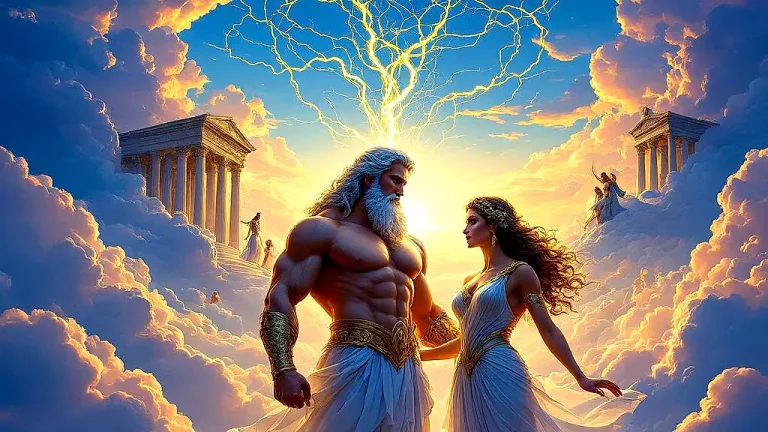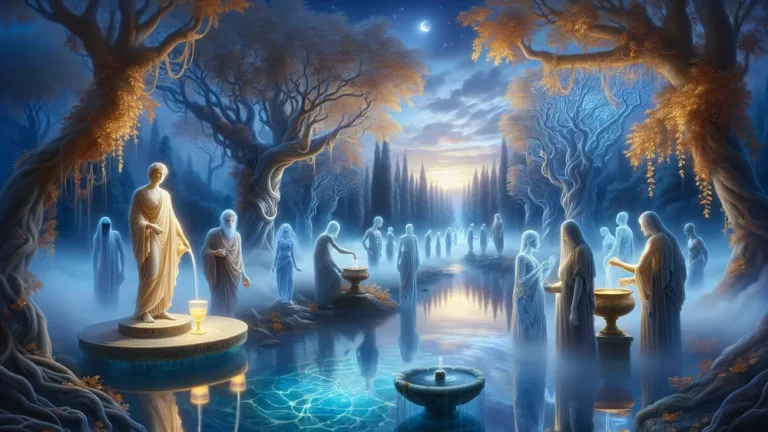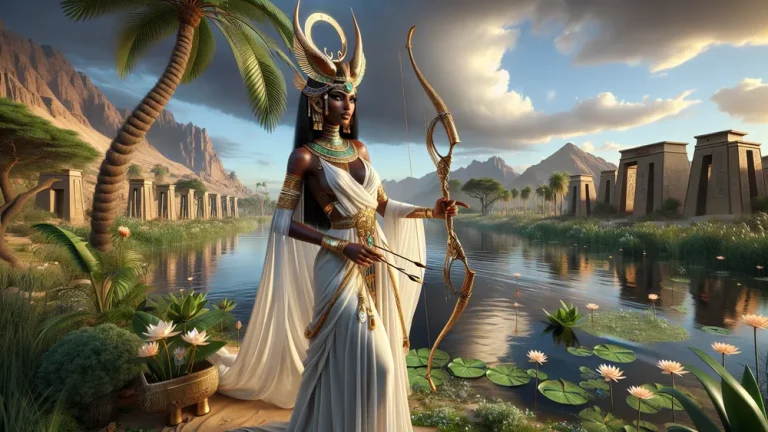The Minotaur: A Tragic Creature Of Greek Mythology
Welcome to looking at the interesting and sad myth about the Minotaur, a beast that causes many thoughts in people’s minds through Greek stories. The Minotaur, often thought of as half-man and half-bull, stays at the center of a big and complex story from ancient Greece.
Key Points:
- The Minotaur is from Greek stories and is part man, part bull.
- Queen Pasiphaë, King Minos’s wife, and Poseidon’s bull caused the Minotaur.
- This creature lived in the Labyrinth, a maze made by Daedalus.
- Symbolism includes chaos, inner battles, and not listening to gods.
- Theseus killed the Minotaur with help from Princess Ariadne’s thread.
- The Labyrinth mirrors life’s complex paths and mind exploration.
- Minotaur stories influenced Greek culture through art and moral tales.
This tale, at its core, is about ideas like what people are, being two things at once, and what happens because gods get mad and people are too proud. There’s a mix of story and meaning that has led to different versions of this myth, each one offering its own special views on old Greek ways and beliefs.
By studying where this creature comes from, what it means to cultures, and the amazing building that held it – the labyrinth – we enter a space where story and meaning connect to talk about deep truths of what being human means. For both mythology fans and those new to it, this look promises to dig up the deep truths hidden in this puzzler of a myth.
Minotaur: Overview and Key Facts
| Key Aspect | Details |
|---|---|
| Story-Based Origin | Comes from Greek stories as a being that is partly man, partly bull. Mainly, the story connects to the island of Crete in old writings. |
| Parentage | The outcome of Queen Pasiphaë of Crete who is the wife of King Minos, with a special bull that Poseidon sent. |
| Physical Traits | People describe it as having the body of a person and the head of a bull; which means mixing animal instincts and human thoughts. |
| Residence | Stays in the Labyrinth, a tricky maze that Daedalus built because King Minos wanted it. |
| Symbolism | It means things like being two things at once, wild chaos, the difficult bits of the human mind, and the outcomes of going against divine rules. |
| Cultural Influence | The tale of the Minotaur affects many parts of Greek art, appears in pottery and sculptures, and it starts many written works too. |
| End | Finally ended by the hero Theseus, who works through the Labyrinth since Princess Ariadne gives him a string. |
Beginnings of the Minotaur Story
To understand the Minotaur’s scary story and its deep meanings, it is necessary first to look at how this creature started. The story is interesting, and it includes important people.
How the Minotaur Came to Be
The story of how the Minotaur started is filled with a complex mix of what the gods wanted, human mistakes, and royal plans. This shows how complex Greek myths are. King Minos of Crete is in the middle of it, and the legend is about how he wanted to prove he should be king.
Because he wanted to prove his position, Minos asked for help from Poseidon, the god, who caused a great white bull to come from the sea as proof. But instead of giving up the bull, Minos, who liked it too much, kept it. So, Poseidon got back at him with tricky vengeance, which resulted in making Minos’s wife, Queen Pasiphaë, like the bull a lot.
Different stories give varied details about how this all happened.
To clearly see how the Minotaur started, break down what happened:
- King Minos asks Poseidon to send proof, getting a great, godly bull.
- Minos doesn’t do what he said he would, keeping the bull because looks are more important to him than gods’ wishes.
- Poseidon reacts by causing Queen Pasiphaë to develop a strong liking for the bull.
- She, needing help to act on her liking, gets Daedalus, a skilled builder, to make a fake cow outfit.
- This makes Pasiphaë and the bull come together and lead to the Minotaur, a strong being part man and part animal.
This series of events means themes like pride and punishment from the gods, which are typical in many myths. It stresses keeping promises to gods as important in Greek tradition.

King Minos’s pride and broken promise to Poseidon led to the creation of the Minotaur after Poseidon punished him by making Queen Pasiphaë fall in love with the bull.
What the Minotaur Represents and Its Importance
Since we’ve gone over where the Minotaur began, we can look into the deep meaning and what it stands for; this creature is important in Greek mythology and outside it too.
Understanding the Meaning Behind the Minotaur
Basically, the myth about the Minotaur is a mix of symbolic meaning, combining ideas of human two-sided nature, chaos, and unseen thoughts. As a creature that is half-man, half-bull, it means the fight between being civilized and having basic urges, and this reflects how we always fight inside to balance thinking and being wild. Chaos is visible in this creature’s body; it means a warning about what can go wrong when we let pride and wild wants take over, like King Minos did when ignoring what gods wanted. To make this easier to think about, see the Minotaur as a picture of inner fights that are often not noticed, much like dreams and unseen thoughts make our lives different without us seeing them. Look at this table for a simple view of these symbolic ideas:

| Symbolism | Description |
|---|---|
| Duality | The mix of thinking and basic urges within what the Minotaur is. |
| Chaos | Hints at the harm from not taking care of duties and being too proud. |
| Human Psyche | Shows battle between thoughts and unseen wants. |
The Minotaur’s Influence in Ancient Greece
The Minotaur myth really spread through ancient Greek life, appearing in art and politics, and also thoughts on morals. Politically, the story means how dangerous too much power can be. Much like Aesop’s fables, it gave examples against unchecked power. In art, the Minotaur was on pottery, frescoes, and coins, a figure that brought both interest and fear, which was common because it was both.

And this can be linked to how figures like the phoenix are in today’s pop culture. Used in philosophy, the Minotaur’s story helped talk about moral issues, such as the effects of pride and human nature. By exploring myths like this, the Greeks could think about their society and personal beliefs in a way that made them reflect.
The Maze of Crete
With the Minotaur’s influence mixed into life and rules of ancient Greece, let’s look at the impressive thing built to hold this scary creature: the famous labyrinth.
How Daedalus Built the Maze
Daedalus was a well-known clever builder of old times. King Minos gave him the job to make a maze on Crete, which was made to hold the scary Minotaur. The way he built things appeared in the careful design of the maze; confusing paths everywhere, so it was almost impossible to get out. Much like modern escape rooms, which mean to puzzle people in hard-to-solve games.
Different stories exist, but Daedalus’s great skill in making a place like a mind puzzle is clear, just like famous pieces of art or machines that surprise and catch our attention nowadays. Stories of Daedalus have made a lasting impact on building history, making people always interested in mazes and the idea of human intellect caught by what it makes.
Deeper Meanings of the Labyrinth
Built by Daedalus, the labyrinth is more than just an amazing building; it’s a strong idea filled with meanings that have made both experts and fans interested for years. At the center of its ideas is what it means about life’s complexity and surprises, like the twisting roads we go through with challenges and the thoughts in our minds.
Like a maze needs focus and determination to get through, living needs you to stay strong and think carefully, pushing you to find your way in confusing times.
In stories, the maze is like a comparison to a person’s mind – it holds the Minotaur, a creature that is both strong and dangerous, representing the hidden worries and wants inside us, just as modern brain studies can reveal the puzzles in our thoughts.
If you put the Cretan maze next to big buildings like pyramids and ziggurats, you see they all share an essential idea that goes beyond their shape, connecting with deep human history. These big constructions, made with detail and purpose, often reveal people’s wishes to link humans to gods, match the universe, or stand for pride and memory. The maze’s story importance is clear as it is seen as a place for trials and change – a spot where you meet symbolic problems to come out wiser or different. Look at this list, which gives the core ideas of the labyrinth:
- Complexity of Life’s Journey: The twisty and complicated roads people must go through.
- Inner Psyche Exploration: Shows the challenges and truths from looking into one’s own mind.
- Trial and Transformation: A place for big personal change and growth.
The labyrinth, built by Daedalus, reflects life’s complicated and unpredictable journey, encouraging personal growth and exploration of our inner thoughts and trials.
The Story of Theseus and the Minotaur
After we understood the labyrinth’s details and its reason, it’s time to explore the famous story of bravery and the meeting that put Theseus right up against the scary Minotaur.
Why Athens Sent Tribute and Theseus’ Mission
People often tell stories about Athens sending payments to Crete, filled with thoughts of loss and the control that ruled Athenian lives. When the Prince of Crete, Androgeos, died because jealous people made plans against him after he won at the Panathenaian Games, King Minos, his father, attacked Athens.
As a result, Athens agreed to send seven young boys and seven girls every nine years to meet their end with the Minotaur in the labyrinth. You might compare this agreement to when strong countries ask for payments to stay in charge or keep calm between them, like in many history tales.
Because of this bad routine, Theseus wanted to stop his people’s pain, and to maybe bring back honor to Athens. He chose to go as part of the payment and promised to kill the Minotaur to save Athens.
How Ariadne Helped Out
In the myth, Ariadne, daughter of King Minos, has a significant part because she gives Theseus a needed thing to get out of the maze – a simple ball of thread. This small act, which seems minor at first, is filled with meaning because Ariadne tells Theseus to unroll the thread when he goes into the maze, making sure he can find his way back after meeting the Minotaur.
It’s like giving someone a map. This looks at why thinking ahead and guidance matter. There are many stories about why Ariadne helps Theseus. Some say it’s love; others say she wants to leave Crete. Giving the thread means there is trust, but Ariadne thinks she will be with Theseus, only to be left behind in some stories.
This change makes her part and fate more complicated.

Theseus’ Battle with the Minotaur
Theseus fights with the Minotaur is a famous scene in Greek myths, meaning his bravery and smarts are proved. When Theseus goes in the labyrinth, he meets this creature, which is part man and part bull, waiting in the dark passages. He has determination and the thread from Ariadne.
The battle has different stories; some mention a harsh hand fight; others talk about how smart Theseus was, like when you face hard problems in life. In many ways, the Minotaur can mean chaos and pure strength, and Theseus might mean order and thinking, showing the old story theme of light against darkness. Despite the tough puzzles in the maze, Theseus wins when he kills the Minotaur.
This win shows sticking with it and using your head over something very hard.

How the Minotaur is Shown in Art and Stories
In art and in stories, the Minotaur has left a big impact. After we have gone through its old and myth stories, we look at how it made a mark in Greek times.
Art and Images of the Minotaur
A mix of strange and sad, the Minotaur means something complex in Greek art, often found on pots, pictures made of tiles, and stone forms. In Greek art, a well-known monster appears, having a body of a man and a head of a bull. Notably, old Greek pots like kylixes and amphorae mean stories of the Minotaur in the maze or losing to Theseus, giving a clear story to people back then. If you think about old art, it’s like comic strips or picture stories today, offering fun and lessons. There are different styles; some focus on the big fight with Theseus, others on the Minotaur by itself. Important Minotaur pictures in art are:
- Black-picture pots showing the Minotaur losing.
- Red-picture pots that focus on the maze.
- Wall and tile pictures from Pompeii with exciting versions of the story. These pictures don’t just mean the style of art in old Greece but also see how people viewed the Minotaur’s story over time.
The Minotaur in Greek art, seen on various old pots, pictures, and tiles, tells complex stories like modern comics, focusing on famous moments like its defeat by Theseus or its presence in the maze, reflecting ancient perspectives on storytelling.
Changes in the Minotaur Myth Through Words
Over the years, people have told the story of the Minotaur again and again, each time adding their own details. In old writings, like those by Plutarch, a Greek historian, and Ovid, a Roman poet, they wrote about the Minotaur as a monster and Theseus as the regular hero. Stories grew and changed to what people liked to hear, so new versions were made, many of which were like fairy tales teaching lessons.
This means tales like the Minotaur can act as a background for stories that show what different societies cared about. With time, when the story was told again during the Renaissance and into modern times, it started focusing more on deep thinking and the mind. Books and changes made later talked about the inside fights of the Minotaur, seeing it not just as a creature but as a part of human thoughts.
These stories, like how old plays by Shakespeare are made to fit today, adapt to what people know now. The ongoing interest in the Minotaur myth, seen in books and plays, shows these stories are not just tales but speak to bigger thoughts and feelings we all know.

The Collection of Greek Mythical Creatures and Monsters
People know Greek mythical creatures and monsters as a rich mix of interesting stories and meanings. The Minotaur, a fearsome creature, is one. So is the majestic Pegasus and clever ones like the Sphinx. Creatures have caught the attention of people for many years.
Their stories mix with gods, heroes, and people, making the myth stories better with ideas of fear, wonder, and what is right or wrong. For a list of all the Greek Creatures and Monsters, you can look at this set, which highlights the world of these legendary beings in myths, showing how the old Greek culture was full of different stories.
FAQs
1. What are the moral lessons from the Minotaur myth?
The moral lessons from the Minotaur myth include the consequences of hubris, the dangers of succumbing to one’s primal instincts, and the inevitable downfall brought on by betrayal and deceit.
2. How does the Minotaur relate to other mythical creatures?
The Minotaur relates to other mythical creatures in that it embodies characteristics of hybridity and monstrous form, similar to entities like centaurs and chimeras.
3. Why is Crete central to the Minotaur’s legend?
Crete is central to the Minotaur’s legend because it was the domain of King Minos, where the mythological labyrinth housing the Minotaur was constructed.
4. Are there real-world origins for the Minotaur myth?
The real-world origins for the Minotaur myth may be traced to the Minoan civilization’s bull-worshipping practices and volcanic disasters on Crete.







